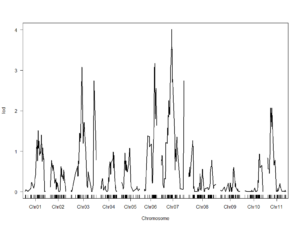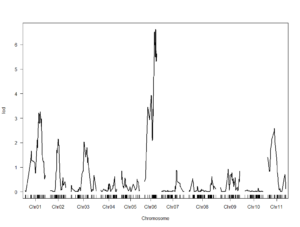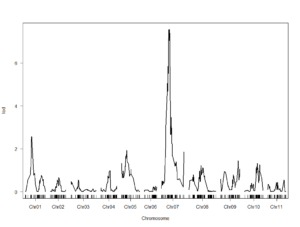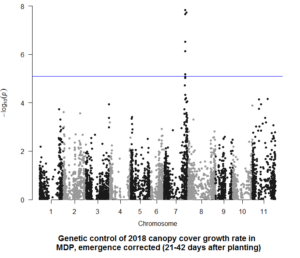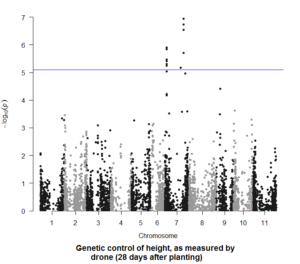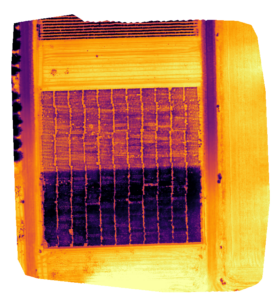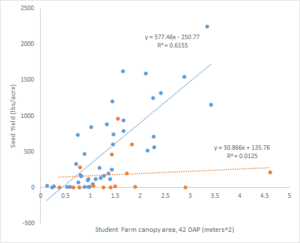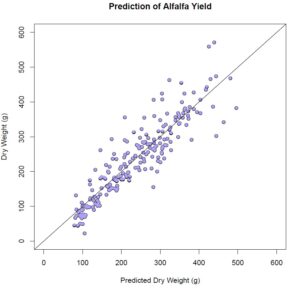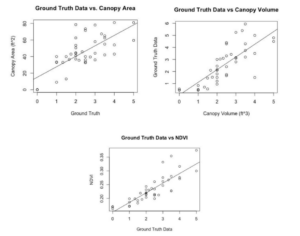Final report for GW18-062
Project Information
Sustainably managed agroecosystems are profoundly different than those that are managed conventionally. Unfortunately, most crop varieties are bred to perform well under conventional systems, and sustainable farmers most often grow varieties that are not optimally suited to their conditions. Evidence suggests that most of the difference in yield between conventional and organic farms, for example, is simply due to the fact that the varieties have been selected based on performance in a conventional, rather than sustainable environment.
Beginning in 2013, we surveyed organic farmers in California to identify their most pressing needs. One major concern for these growers is weed control. With limited use of herbicides, sustainable farmers need access to crop varieties with alternative canopy structures that allow for mechanical weed control and reduce hand-weeding costs. It is also vital for crop canopies to grow rapidly early in the season to outcompete weeds. Finally, sustainable growers need crops that are sensitive to abiotic pressure, such as heat stress, in a rapidly changing climate. To date, selection for these characteristics has been slow, expensive, and imprecise, but improvement of these traits is crucial for sustainable agriculture.
In the last three years, we have developed inexpensive, cutting-edge imagery acquisition and processing methods that facilitate the selection of varieties with an optimal canopy structure and vigorous growth rate. These have been disseminated to the next generation of agricultural innovators through on-farm field day demonstrations, personalized trainings with academic and industry partners, a new course offered at UC Davis, and workshops and presentations at scientific conferences. These methods have now been employed to study rice, alfalfa, spinach, wheat/triticale, grapes, tree crops, and several species of bean. Next, we identified genetic patterns associated with vigorous growth rate across multiple populations of common bean, which will be useful for efficient marker-assisted selection of improved varieties. We then screened breeding populations using these tools, and identified patterns of improvement in our breeding populations relative to their heirloom parents. Finally, we have conducted multi-location trials of advanced-generation breeding lines that excel in terms of yield, product value, and disease resistance. These selection tools and new varieties will be tremendously valuable for sustainable farmers in the western United States.
1) Develop high-throughput phenotyping methods for stress resilience and yield that can be used by growers or breeders. Physiological characteristics such as canopy temperature and NDVI are correlated with plant health, and may be associated with faster growth rate. They are also correlated with yield and abiotic stress resistance, but methods for analyzing the data have lagged behind the ability to collect it.
2) Identify the genetic basis of vigorous early season growth. We have developed a population descended from a slow growing, bushy dry bean parent (Orca) and a fast-growing, viney parent (Black Nightfall). With genotype data, we will be able to determine the genetic cause of variation in these traits.
3) Release new varieties of dry bean that excel in early season growth rate, canopy structure, and yield under variable environmental conditions. We will use high-throughput phenotyping and marker-assisted selection to improve early season growth rate, canopy structure, and other characteristics in dry bean. These releases will primarily fall into high-value heirloom market classes, which fetch a higher price than commodity market classes.
4) Disseminate breeding tools and new crop varieties to a wider audience We will disseminate our precise and inexpensive phenotyping methods through publications targeting growers and researchers. Genetics results will be published in peer-reviewed scientific literature accessed by plant breeders. Our new varieties will be showcased at our annual on-farm field days, and will be trialed by collaborating growers that produce common bean commercially. Publications on their release will be found in a variety of formats read by scientists and sustainable growers.
Cooperators
- (Researcher)
Research
Three main populations have been evaluated in this project. One population, the BeanCAP Middle American Diversity Panel (MDP), includes 280 highly diverse common bean varieties that are all descended from one of the domestication events in common bean. These were genotyped by Illumina BARCBean6K_3 Beadchip and Genotyping by Sequencing (GBS). These were grown to identify the genetic basis of canopy height, growth rate, and other canopy characteristics. A second population was developed specifically to study early season growth rate. It consists of 240 recombinant inbred lines descended from crosses between Black Nightfall and Orca. Black Nightfall is a fast growing variety that competes effectively against weeds. Orca is very slow growing, and is not competitive against weeds. This population segregates for early season growth rate. DNA from each RIL was extracted through a modified CTAB procedure, and genotyped with the BARCBean6K_3 BeadChip. A genetic map was constructed based on this data using the ASMap package in R, and QTL mapping was conducted using R/qtl. The third population is a diverse assemblage of breeding materials and the heirloom varieties and university-developed types they are descended from. Hundreds of heirloom varieties were grown between 2013 and 2016 to identify promising candidates. No heirloom lines combined rapid early season growth rate, bean common mosaic virus (BCMV) resistance, and consistently high yields. Donors for these characteristics were carefully chosen, and cross-pollinations were conducted between heirloom types and breeding lines developed by universities. The breeding program has progressed by a) the pedigree method, selecting for the above-mentioned characteristics and ideal seed coat color, and b) recurrent backcrossing for BCMV resistance. In the latter case, naturally occurring resistance alleles are "diluted" into the genetic background of the heirloom by a series of selections and cross-pollinations with the heirloom parent (recurrent backcrossing).
During the growing season, flights were conducted weekly from 3 weeks after planting (WAP) to 6 WAP for all populations. Until 3 WAP, the plants are small and the aerial imagery is not sufficiently detailed to generate meaningful data. Starting around 6 WAP, the plants transition into reproductive growth and begin to lodge, so increased canopy area after this point is not necessarily beneficial. Later flights were conducted throughout the season to continue the evaluation of canopy health throughout the growing season. This series of flights was conducted using a Phantom 3 Pro over the MDP and breeding population in 2016. In 2017, Phantom 3s were used to collect true color red/green/blue (RGB) and multispectral data over the MDP and Black Nightfall/Orca populations. The RGB and multispectral data were collected using a stock camera and Parrot Sequoia, respectively. Flights were typically planned in DJI Ground Station Pro. Imagery was processed into orthomosaics and digital surface models using Pix4Dmapper Pro. QGIS was used to extract data from each plot in the field, and advanced data extraction and statistical analyses and were done in R.
RGB, multispectral, and thermal data were collected for all populations in 2018. The 2018 breeding populations had been narrowed down to 10 breeding lines, five heirloom varieties, and three varieties released by universities as controls. These breeding lines were grown in three replicates in each of three organic field locations, along with a single replicate in one conventional field. In 2017 and 2018, the MDP was grown as two independent augmented designs, while the Black Nightfall/Orca population was grown in a single augmented design. The 2018 breeding trials were located on certified organic farms in San Diego, Monterey, and Yolo counties in California. In 2016, the MDP was grown in a single augmented design. In 2019, the Black Nightfall/Orca population is being grown in two augmented designs for a third and final season. The 2019 breeding trials include three replicates of eight breeding lines, five heirloom parents, and three university-developed controls. This trial is being conducted in Yolo, San Mateo, San Luis Obispo, and San Diego counties in California, and at Fedco seeds (two replicates) in Maine. Tests of some of these lines is also occurring in Shasta county and a second location in Yolo county. Row 7 seeds is conducting a taste test of the varieties.
Raw imagery from drones was compiled into orthomosaics and digital surface models using Pix4Dmapper. Using QGIS, a grid of shapefiles was laid over each field using the vector grid function. Normalized Difference Vegetation Index (NDVI) orthomosaics were then used to separate canopy from soil based on an NDVI threshold of 0.5. This layer was used to calculate canopy area and eliminate soil values as needed. Digital surface models were used to extract the heights of plants and soil in each plot. The median elevation of the soil was subtracted from the mean canopy elevation to determine the average height of plants in a plot. Maximum plant heights were determined based on the median soil elevation subtracted from the maximum canopy elevation. This process requires only a few minutes to accomplish per field once the models are loaded into QGIS, regardless of the number of plots, making it scale efficiently for large trials. UAV-determined canopy heights were then compared to hand-measured heights. Genome wide association studies (GWAS) were carried out for changes in canopy area, height, and other characteristics in the MDP. This was done by GLM in TASSEL through the SNiPlay web interface. A minor allele frequency threshold of 0.1 was used for all tests, with a correction for population structure using the first five principal components of the genetic data. Significance was determined based on a Bonferroni correction based on an alpha of 0.05.
| Trait | mean (BN) | mean (Orca) | SD (BN) | SD (Orca) | p-value (two-tailed t-test) | Significance |
| 2016 emergence | 44.83 | 41.33 | 14.13 | 12.69 | 0.66 | ns |
| 2017 emergence | 26.38 | 12.75 | 6.39 | 7.07 | 0 | ** |
| 2018 emergence | 159.63 | 109.88 | 6.36 | 19.19 | 0 | *** |
| 2016 canopy growth rate per PLOT (cm2/(plot*day)) | 400.29 | 207.11 | 124.08 | 50.12 | 0.01 | ** |
| 2017 canopy growth rate per PLOT (cm2/(plot*day)) | 895.68 | 193.46 | 168.61 | 82.76 | 0 | *** |
| 2018 canopy growth rate per PLOT (cm2/(plot*day)) | 2807.86 | 1628.28 | 142.27 | 167.67 | 0 | *** |
| 2016 canopy growth rate per PLANT (cm2/(plant*day)) | 9.2 | 5.63 | 1.82 | 2.7 | 0.02 | * |
| 2017 canopy growth rate per PLANT (cm2/(plant*day)) | 34.62 | 17.22 | 5.65 | 5.58 | 0 | *** |
| 2018 canopy growth rate per PLANT (cm2/(plant*day)) | 17.60 | 15.26 | 0.78 | 2.96 | 0.06 | ns |
| 2016 canopy height 42 DAP (cm) | 38.31 | 28.15 | 2.46 | 2.94 | 0 | *** |
| 2017 canopy height 42 DAP (cm) | 49.37 | 39.29 | 1.35 | 1.65 | 0 | *** |
| 2018 canopy height 42 DAP (cm) | 51.59 | 43.66 | 2.00 | 2.61 | 0 | *** |
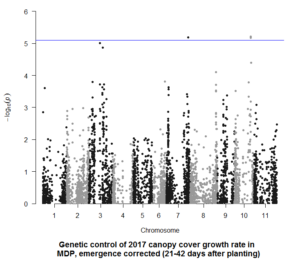
2017 GWAS of early season growth rate (3-6 WAP) in the MDP. SNPs on chromosomes 7 and 10 are significantly associated with early season growth rate. SNPs on chromosome 3 are nearly significant and may also play a role in growth rate.
References:
Research Outcomes
Education and Outreach
Participation Summary:
Knowledge gained through this project has been disseminated in several ways. The Gepts lab field day, which attracts dry bean growers from across California, included an in-field discussion of the project and a UAV demonstration flight. Another field day for organic growers and undergraduates lent exposure to the organic breeding fields. This project was also discussed as a poster presentation and UAV demonstration flight at the National Association of Plant Breeders annual meeting in August 2017, and a poster was presented on it at the Student Organic Seed Symposium, which attracts graduate students and industry representatives. Another poster was presented at the International Plant and Animal Genomics meeting and the UC Davis Plant Science symposium.
Knowledge gained using this equipment prepared the graduate student to develop a course on the use of UAVs in Agriculture. The course was the first of its kind at UC Davis, and was offered in Spring 2018. Students ranged from first year undergraduates to graduate students and a post-doctoral researcher. The class combined theoretical knowledge about aircraft, sensors, and legal regulations with practical knowledge on planning autopilot missions, generating orthomosaics and 3D digital surface models, and data extraction. Students ultimately completed a final project in which they posed original research questions and answered them using UAV imagery they collected themselves. Subsequently, a graduate student from Burkina Faso and industry representatives from a major organic company have been trained on the use of UAVs. Knowledge gained from this project has been passed on to a new generation of agricultural scientists, greatly increasing its total impact.
Outreach has also targeted the general public. The project was featured in a UC Davis press release that was circulated widely on social media (see http://sacramento.ucdavis.edu/news/uc-davis-students-breed-beans-organic-farming). An article for Organic Farmer magazine is planned for publication in autumn 2018. The project will also be featured on a PBS special. Filming for this program began in July 2018 with on-farm field visits, interviews, and demonstration flights. Filming will continue for the chef-led flavor evaluations at Rio del Rey Farm in autumn 2018. These opportunities will help generate public awareness for the crop varieties, and will serve as a form of marketing for them as emerging products. Ultimately, this will increase demand and improve sustainable farm profitability.
Information Products
- UC Davis Students Breed Beans for Organic Farming
- Breeding Common Bean to Maximize Culinary Quality and Field Performance
- PLS 198: Unmanned Aerial Vehicles (UAVs) in Agriculture (Spring 2019)
- PLS 198: Unmanned Aerial Vehicles (UAVs) in Agriculture (Spring 2018)
- Developing high-value varieties of bean for organic agriculture
- New variety announcement for growers, slide 1
- New variety announcement for growers, slide 2
- LASER talk
- Introducing Drone Flight and Image Processing
